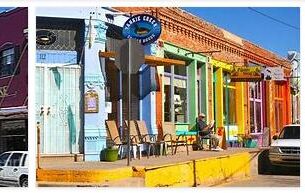Toronto [English tə r ɔ ntə ʊ ], capital of the province of Ontario, Canada, on the north shore of Lake Ontario, (2019) 6470000 residents in the metropolitan area (Greater Toronto Area, GTA); Core city 2.97 million residents.
In 1998 the 6 boroughs of the former “Metro Toronto” were united to the “City of Toronto” with 630 km 2 and 2.73 million residents. The entire Greater Toronto Area covers 7,124 km 2 and is Canada’s largest concentration of population. Anglo-Canadians of British descent are now only a small majority, as are numerous other ethnic groups, including the United States. Chinese, Irish, Italians, Indians, Portuguese, Germans (4.6%), some of whom live in certain residential areas (e.g. China Town, Korea Town etc.). Toronto is the second most important destination for international immigrants (after Miami, USA), almost half of the population was born abroad.
Toronto is the most important economic, commercial and financial center of Canada as well as the leading cultural and educational center of Anglo-Canada, furthermore the seat of a Catholic Archbishop, an Anglican and a Ukrainian-Uniate Bishop. Important educational institutions are the University of Toronto (founded in 1827), York University (founded in 1959), Ryerson University (founded in 1948 as the Institute of Technology), the Conservatory, the School of Organists and the School of Art. Libraries, museums (Art Gallery of Ontario, Royal Ontario Museum, Ontario Science Center, etc.), planetarium, zoological garden are other cultural institutions. Various leading newspapers appear in Toronto (e.g. Globe and Mail) and the city is also the most important location for the Canadian film industry.
The most important economic factor is the service industry, especially in administration, trade and transport, banks and insurance companies; the Toronto Stock Exchange is one of the most important in the world. The diverse industry includes, among others. Metal processing, electrical engineering and mechanical engineering, automotive, high-tech, wood, chemical and printing industries.
According to historyaah, Toronto has a major port and Canada’s largest international airport (Lester Pearson Airport). There is good access to traffic through highways, train connections, the bus network and the subway. The metropolis is also the country’s most important travel destination.
Cityscape
The old town is laid out in a checkerboard pattern. Its oldest preserved brick building, »The Grange«, is a typical mansion from 1830 (museum since 1911). This is followed by the new buildings of the Art Gallery of Ontario (including 1926; 1989–92 by Barton Myers, * 1934, among others). The central business area with high-rise buildings is located in the historic city center not far from Lake Ontario. B. the shopping center “Eaton Center” (1976–81, by Eberhard Zeidler, * 1926); The Cadillac Fairview Tower (1981) and Queen’s Quai Terminal (1983–84) were also designed by the same architect. Also of importance are Roy Thomson Hall (concert hall; based on plans by Arthur C. Erickson, * 1924, † 2009) and sports arena »Skydome« (1989). Landmarks of the modern city are the City Hall (1958–65, by V. G. Revell) and the Canadian Tower (553 m high telecommunications tower, inaugurated in 1975).
Numerous underground shopping malls have been built since 1967, connecting office buildings, hotels and underground stations. The further expansion of the metropolis has recently been intensified. Numerous new skyscrapers are being built around the harbor area. With the new opera house (“Four Seasons Center”; architect: Jack Diamond [* 1932]) and the extension of the Gardiner Museum of Ceramic Art (architects: KPMB Architects under the direction of Bruce Kuwabara), two important cultural sites were opened or reopened in 2006. In 2006/07 the redesign and expansion of the Royal Ontario Museum (ROM) took place according to plans by D. Libeskind and in 2007/08 the reconstruction of the Art Gallery of Ontario (AGO) according to designs by F. O. Gehry.
Noteworthy is the Sharp Center for Design, built in 2004 as an extension of the Ontario College of Art and Design (OCAD) based on plans by the British architect Will Alsop (* 1947, † 2018). Not far from the new opera, the new festival center for the Toronto Film Festival (architects: KPMB) was opened in 2010 in King Street West. In the outskirts, the city has extensive residential areas (suburbs) with predominantly single houses, interrupted by high-rise concentrations, shopping centers, industrial and office complexes. The L Tower, completed in 2015, is a residential high-rise by D. Libeskind. In the east of the metropolitan area J. Andrews built 1964-67 the Scarborough College of the University of Toronto.
History
Initially a settlement of the Iroquois (Teiaiagon), there was a small French storage place here from 1720–30, a larger fortified settlement (Fort Rouillé) from 1750 / 51–59; After the founding of the – predominantly English-speaking – province of Upper Canada (1791), the settlement of York was laid out in 1793 (provincial capital from 1796). It was promoted to City in 1834 under the name Toronto; since 1867 it has been the capital of the province of Ontario.



